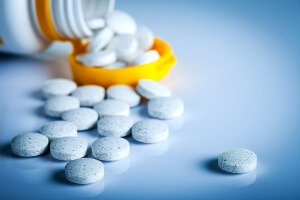Ecstasy Addiction: Symptoms, Effects, and Rehab Treatment
Ecstasy, a synthetic drug, has the properties of both hallucinogenic drugs such as LSD and stimulant substances like amphetamines. Ecstasy produces feelings of heightened energy, pleasure, and empathy while also producing mild sensory effects characterized by feelings of emotional openness and closeness to others.1 However, ecstasy use can also result in several unpleasant, even dangerous side effects and long-term, heavy use may result in cognitive impairments such as problems with learning and memory.1
Continue reading to learn more about ecstasy, its potential for addiction, its side effects, and treatment options for its misuse.
What Is Ecstasy?
Ecstasy refers to the street name of 3,4-methylenedioxy-methamphetamine, or MDMA.1 Also known as Molly, XTC, E, X, beans, and Adam, ecstasy is classified as a Schedule I substance under the Controlled Substances Act.2 Schedule I drugs are considered to have a high potential for misuse and currently have no accepted medical use.3

Typically ingested in a pill, tablet, or capsule form, ecstasy sometimes comes in liquid or powder form. Ecstasy is often referred to as a “club drug” due to its frequent use at dance parties and raves, however, it is also used at house parties, social gatherings, or with sexual partners.4 Individuals take ecstasy for effects that include enhanced energy, endurance, sociability, and sexual arousal.1,2,5 Despite being classified as a hallucinogen, MDMA does not typically produce major alterations in sensory perception but rather heightens empathy and feelings of closeness.6
Ecstasy works by increasing the activity of certain neurotransmitters—serotonin, dopamine, and norepinephrine—in the brain.1
Serotonin is a chemical that’s instrumental in mood regulation, pain perception, sleep, sexual urges, and appetite. Boosted levels of serotonin from ecstasy use can lift an individual’s mood and heighten feelings of affection, empathy, and sexual arousal.1
Norepinephrine controls heart rate and blood pressure. Using ecstasy can trigger elevated blood pressure and an irregular heartbeat.1
Dopamine produces increased levels of energy and activity and reinforces behavior in the brain’s reward system.1
Effects of Ecstasy Use
It usually takes around 30–45 minutes for a person to feel the effects of MDMA, which can then last anywhere from 3 to 6 hours.2,5
In addition to emotional openness and closeness to others, as well as euphoria, increased energy, sexual arousal, and similar feelings, ecstasy use may also result in a number of adverse side effects, which may include:1,2,5,7
- Nausea.
- Headache.
- Dry mouth.
- Reduced appetite.
- Visual disturbances.
- Involuntary jaw clenching.
- Muscle and joint stiffness.
- Blurred vision.
- Anxiety.
- Illogical or disorganized thoughts.
- Paranoia.
- Sweating.
- Chills.
Additionally, individuals who use ecstasy in crowded, hot, overstimulating environments—such as in nightclubs or at raves—where they are also participating in intense forms of exercise like dancing or jumping, risk developing hyperthermia (a dangerously elevated body temperature). While rare, this condition can lead to dehydration, fainting, seizures, and organ failure (particularly of the kidneys, liver, and heart) if left untreated.5
Some studies have shown that long-term, heavy use of ecstasy can cause problems with learning or memory and other cognitive impairments.5 People who use MDMA often also use marijuana, and chronic marijuana use is associated with similar cognitive damage.4 This combination may have a more deleterious effect than either drug alone.7
Additional Dangers of Ecstasy Use
Individuals who use MDMA risk ingesting unknown substances, which are often found in illicitly purchased ecstasy pills, capsules, tablets, and powders. They may think they’re purchasing ecstasy when they are, in fact, buying other substances instead of or in addition to MDMA. These substances can vary widely, and may include methamphetamine, PCP, ketamine, cocaine, caffeine, pseudoephedrine, heroin, PMA (par methoxyamphetamine), the over-the-counter cough suppressant dextromethorphan (DXM), and synthetic cathinones (bath salts).5,8,9 Unintentional ingestion of some of these substances can produce dangerous or even deadly effects.
From 2017-2021, the supply of eutylone, a synthetic cathinone, rapidly increased in the United States. Authorities issued public alerts to include concerns about a potentially elevated overdose risk associated with eutylone being sold as MDMA. Furthermore, research indicates that eutylone-involved deaths commonly co-involve illicitly manufactured fentanyl. Studies show that approximately 1 in 10 eutylone-involved deaths in 2020, had evidence of current or past MDMA use but no toxicology finding of MDMA, which supports the idea that individuals unintentionally ingest eutylone and other cathinones when they think they are taking MDMA.10
Statistics on Ecstasy Use
In 2020, 2.6 million people aged 12 or older reported ecstasy use in the past 12 months.11 Among adolescents aged 12 to 17, 78,000 individuals reported using ecstasy for the first time that year.12
Ecstasy Addiction
Although there is not as clear-cut of an association between MDMA and the compulsive patterns of use more commonly seen with certain substances like alcohol or heroin, MDMA use—and the consequences of use—can still be problematic.4
Take Our Substance Misuse Self-Assessment
Take our free, 5-minute substance misuse self-assessment below if you think you or someone you love might be struggling with substance misuse. The evaluation consists of 11 yes or no questions that are intended to be used as an informational tool to assess the severity and probability of a substance use disorder. The test is free, confidential, and no personal information is needed to receive the result.
Symptoms of MDMA Addiction
Research suggests that regular MDMA use produces adaptations in the brain that are associated with substance use disorders and related behaviors, such as impulsivity. However, there is a lack of data that assesses MDMA dependency and addiction.5
Healthcare professionals use the Diagnostic and Statistical Manual of Mental Disorders, 5th edition (DSM 5) to identify and diagnose a substance use disorder or a hallucinogen use disorder. Signs of a substance use disorder, or addiction, include:13
- Taking ecstasy in larger amounts or for longer than intended.
- Unsuccessfully attempting to cut down on ecstasy use.
- Spending a lot of time trying to find ways to obtain, use, or recover from ecstasy use.
- Experiencing strong cravings for ecstasy.
- Using ecstasy causes the neglect of day-to-day responsibilities at work, school, or home.
- Continuing to use ecstasy even though it results in or amplifies social or interpersonal conflicts.
- Giving up social, occupational, or recreational activities due to ecstasy use.
- Using ecstasy in risky situations (e.g., while driving).
- Continuing to use ecstasy even though it knowingly causes or exacerbates physical or psychological problems.
- Developing a tolerance to ecstasy and needing to increase the amount to achieve intoxication.
Although research suggests there isn’t an MDMA withdrawal syndrome, there are subjective reports of MDMA withdrawal or “come-down” following repeated dosing, and some individuals may feel fatigued or have a depressed mood.6
Ecstasy Addiction Treatment, and Rehab
While there are currently no medical treatments specifically for ecstasy addiction, behavioral therapy like what’s used for other substance use disorders may be beneficial.1,5 Some common treatment options for drug addiction include:5,14
- Detox. Detoxification utilizes various medications and interventions to help manage an individual’s withdrawal symptoms safely while keeping them as comfortable as possible.
- Inpatient or residential care. Inpatient settings provide treatment in a residential facility or hospital, where individuals can be monitored 24/7. Inpatient care typically includes individual and group counseling, education, and behavioral therapies, including cognitive-behavioral therapy (CBT), which has been a successful intervention for some individuals who struggle with ecstasy misuse. CBT helps individuals identify and modify the thoughts, emotions, and behaviors that led to ecstasy misuse and learn skills to cope with stressors and avoid relapse.
- Outpatient services. Outpatient care provides the same programs as inpatient care but individuals return home or to a sober living environment at the end of each day. Depending on the program and an individual’s specific needs, requirements vary. Some individuals may attend counseling and therapy sessions once a week; others may have sessions multiple times per week for several hours each day.
- Aftercare. Once the formal treatment program ends, ongoing or continuing care helps an individual maintain their sobriety with follow-up programs, alumni support networks, individual counseling, mutual-help groups, and group therapy sessions.
Treatment may be at least partially covered by your insurance. If you or someone you love is struggling with MDMA misuse or addiction, contact American Addiction Centers (AAC) today at .

